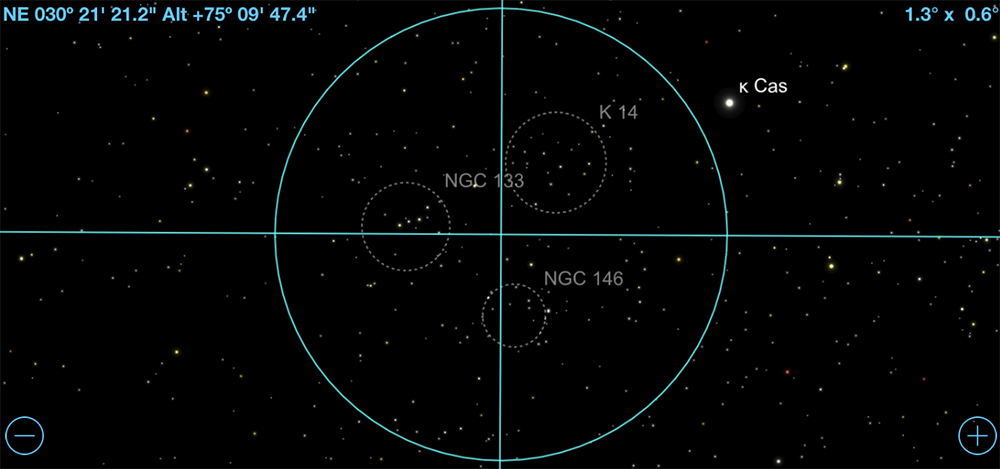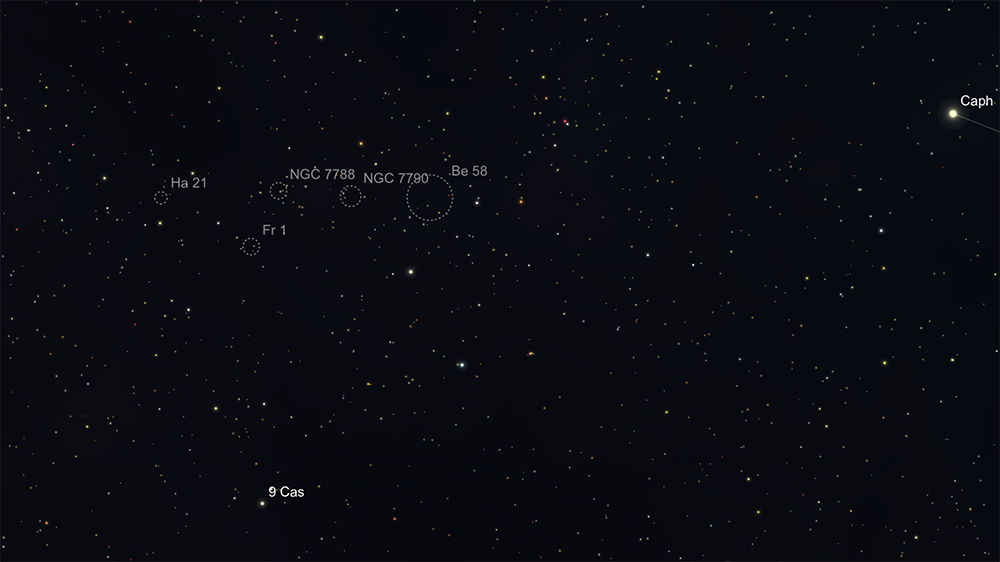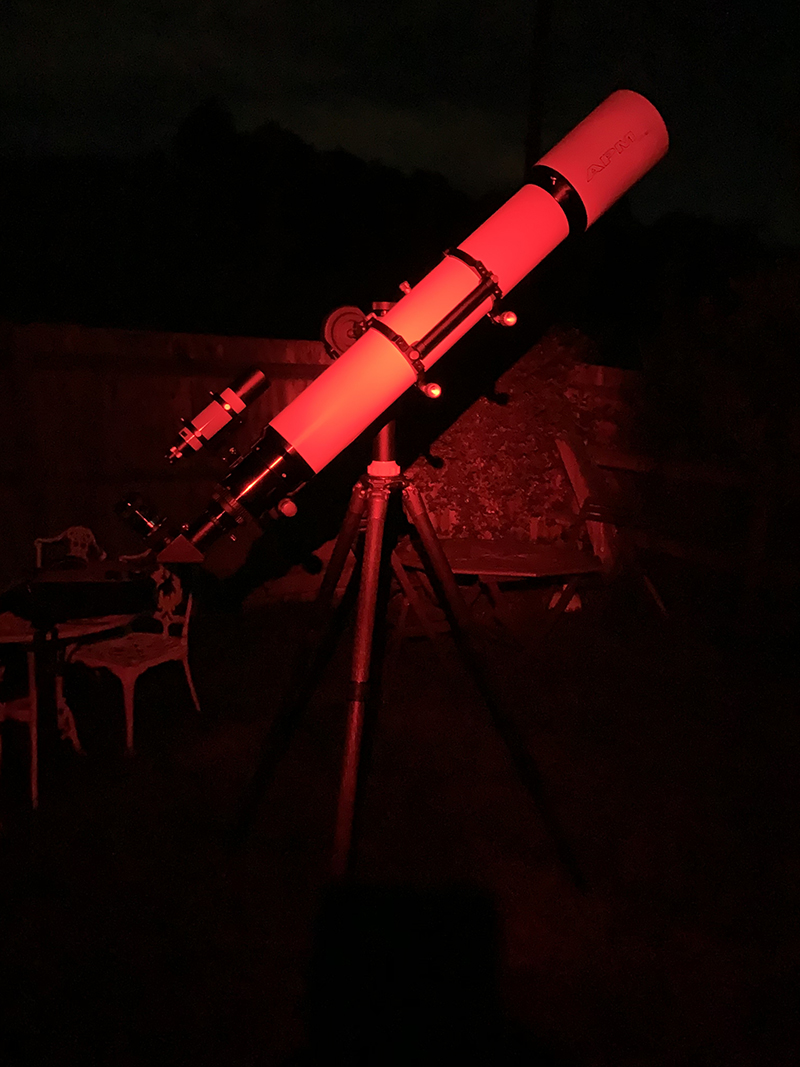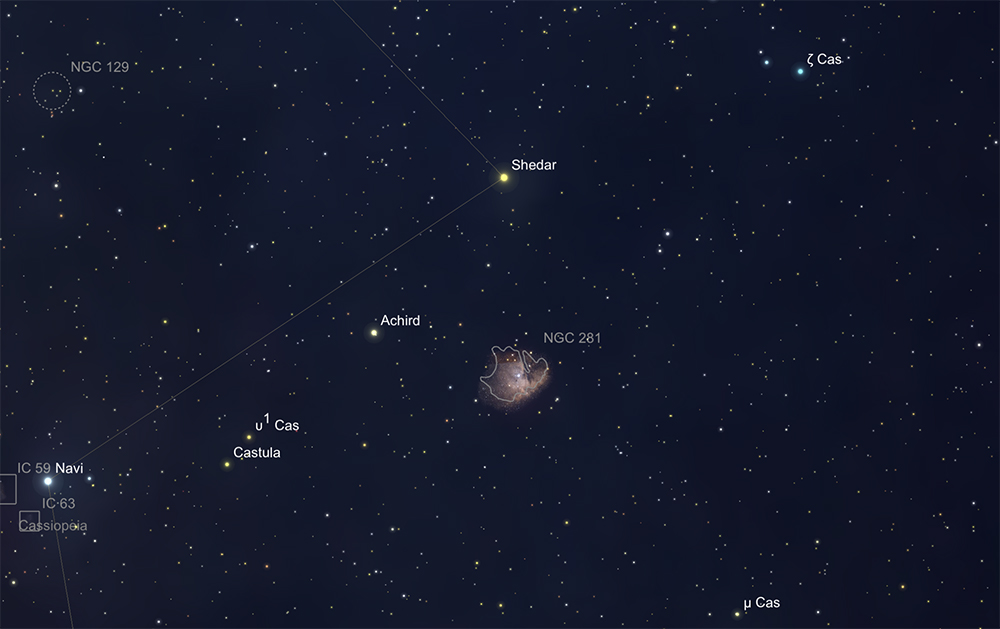To read part one of the observing report detailing my goal to observe all Open Clusters in Cassiopeia brighter than magnitude +12 (based on Sky Safari 5 Pro database), please click here. It includes details of the equipment used and a list of the targets as well as the observations of the first 22 Open Clusters on the list and how to find them.

Busy part of the sky! Showing only Open Clusters to mag +12 based on Sky Safari 5 data. Several clusters appear to have similar magnitudes but estimates are not available so they did not make the cut. Source: Sky Safari 5 Pro.
Just 2/3 of a degree north-west from one my favourite OCs, the E.T Cluster, lies NGC 436. Switching to the 10mm Delos for 120x, revealed just over a dozen faint stars wrapped in haze. The slightly brighter stars appeared arranged in a diamond shape inside a small Southern Cross asterism.
Switching back to the 21mm and placing Navi on the field stop, meant that NGC 381 was almost exactly opposite on the other edge of the field of view. However, at only 6’ the cluster required higher magnification and I used the 10mm. The shape of the unresolved light of the cluster appeared somewhat like the Emerald Isle and the small clusters of embedded points of light appeared as cities across Ireland. Additionally, four slightly brighter stars curved around the edge of the “land mass” like cruise liners sailing away.
Along with Mario, Sonic, and Lara, there is arguably no more famous videogame character than Pacman, and his nebula namesake and its associated open cluster IC 1590 was my next port of call. Using the 21mm it was a 1.6-degree hop from Shedar. However, despite being on an OC mission, I could not resist a quick glance at Shedar itself which is a beautiful colour contrasted double. The pale topaz primary and lilac secondary were quite beautiful even at 57x. Subtle nebulosity was immediately obvious as the celestial pill muncher moved into view. I switched down to the 17mm to get a better view of the small embedded cluster at the heart of the nebula, which is located around multiple star HD 5005. There were several clumps of slightly brighter nebulosity located around the cluster which made judging the full extent quite hard, but a few more stars, including the known secondary to HD 5005 were resolved. Allowing myself one more distraction before moving on, I screwed in my UHC filter which really increased the prominence of the gaseous material, helping to delineate the shape of Namco’s arcade character.
Heading back to Navi once again, I used NGC 381 to springboard to rather faint Czernik 3, which lies about 80’ north-west from my Emerald Isle. My notes on this cluster are sparse. At only 2’ in diameter and around +10 magnitude, it was not going to be one to knock my socks off. Using the 6mm I was able to tease out an irregular “V” shape smudge with some hints of granulation. However, poor visual appearance does not imply not interesting. While writing up this report I googled this cluster to discover an Indian team of astronomers published in the Monthly Notices of the RAS on the 10th September 2020 (the same day I observed it) the results of a study which suggest it is older and further away than previously believed, and the elongated and distorted morphology indicates it is disintegrating, so interested observers better take a look before it is gone! 😉
Just over one-degree to the west was Berkeley 62. With a stated apparent size of 10’ I switched back to the 10mm. I noted an isosceles triangle and a short chain of three more stars separated by a couple of arcminutes. There were also some hints of a few more stars.
Using the 21mm Ethos made the almost 2-degree move north-west to my next two targets, King 16 and Berkeley 4 easy. Getting closer with the 10mm nicely framed both clusters. A small hook of stars with a sprinkling of dust specks seen in King 16 was the highlight. Berkeley 62 appeared as a triangular smudge with one distinct star sitting at the base.

The forecast for the night of observing. In reality it was clear from nightfall. Source: Clear Outside
Heading back to the centre of the “W” and sweeping across less than 2o from Navi, revealed NGC 225. Using the 21mm to locate the 12’ diameter cluster actually showed an interesting pattern of field stars in two sweeping arcs around ½ a degree in size which made me think of Butterfly wings which came to a point at NGC 225 and the base of the abdomen of my imagined celestial insect. Switching up to 120x opened up the cluster which gave a very loose appearance as though gravity was losing the battle to keep these siblings together. I switched back down to the 17mm which tightened up the cluster and was the more pleasing view. Long exposure images reveal some nebulosity associated with some of the brighter cluster members though I did not detect any visually.
Far less impressive visually, but intrinsically the superior cluster, Stock 24 just creeps into the field of the 10mm if NGC 225 is placed at the bottom of the eyepiece. Only humbled by its almost 3x greater distance, St24 contains around 180 stars. Two small groupings of stars were seen in this 5’ cluster, both resting on the unresolved delicate light of the other cluster members which my 5” scope failed to perceive.
NGC 189 and Stock 24 are contained within the same field of the 21mm so locating this small cluster was not tricky. Switching back to the 10mm again, a small pretty cluster was seen with a couple of gently arcing star spindles swirling from the central region. One aspect of the cluster which caught my attention was the apparent brightness of the background sky compared to NGC 225. Reviewing star charts more closely the next day showed that NGC 189 nestles in a brighter part of the Milky Way whereas NGC 225 sits atop a dark cloud, so while far less impressive at the eyepiece, a similar effect as seen with M6 and M7 in Sagittarius.
The field of my finder is 6.3o, which is very slightly wider than the direct separation of Navi and Caph. NGC 129 sits almost directly central on this imagined line which made finding my next target very easy. Placing each star on the opposite edge of the finder field placed my quarry directly in my sights. This one was worth lingering on for a few moments at 120x. Two distinct groupings of stars were seen, separated by a dark lane. Both parts were quite loose, with one containing an obvious brighter wedge which pointed towards the bright star HR113. The second clump were more equal in brightness and seemed to form a narrow “V” shape.
Moving the scope west to star 12 Cas and leaving it near the field stop, placed NGC 103 towards the opposite edge. I struggled to get much out of this one. “Small and uninteresting” was my first note. Perhaps a little unfair. With some time, I made out a gently waving patch of light with a couple of embedded stars.

Showing the 0.6 degree field of my 10mm Delos eyepiece, the three OCs, King 14, NGC 146 and NGC 133 appeared as one excellent cluster.
The next three clusters on my list are contained within an area of less than 20 arcminutes. Using 12 Cas as the departure point, less than one field width of the 21mm south was King 14, NGC 146 and NGC 133. Switching to the 10mm nicely framed all three. With the rich background star sky, my initial impression was that of one impressive cluster. While I no doubt struggled to separate some of the field stars from the cluster members, I spent a bit of time convincing myself of the individuals borders. King 14 was the most impressive cluster with a couple of tight knots of stars and another tiny Delphinus at centre of the cluster. NGC 133 contained the brightest individual stars with four in a slightly wonky line with a couple of fainter companions in attendance. Intrinsically most distant NGC 146, held my gaze for the shortest time with a haphazard spread of faint cluster members.
Centring Caph, one end of the “W” asterism which makes up Cassiopeia, NGC 7789 was half a finder view to the north and easy to pick out in the 7×50 unit. Discovered in the Autumn of 1783 by Caroline Herschel, this wonderful cluster now bears the colloquial name of Caroline’s Rose and it is truly deserved. With no overly bright members to distract the eye, the loops and twists of dozens upon dozens of stars seem to trace out the petals of the romantic flower. I found the most pleasing view with the 17mm which provided a nice framing but kept the 30’ cluster well compressed which helped to keep the petals in view.
Five of my final six targets fit in the field of the 21mm Ethos (and King 12 as well but with unknown magnitude it did not make the cut). Once I located the patch of sky containing these deep sky denizens just over one field width south-west from Caph, I switched to the 10mm Delos to take a closer look.

All five of these open clusters fit in the field of my 21mm Ethos (in fact a 6th, King 12 was also visible but did not make the cut due to unknown magnitude estimate.
Berkeley 58 was the first cluster in this line of five. Contained within the central third of the 10mm, all the stars were quite faint but I was able to trace out a stick figure that seemed to be pulling the Usain Bolt “Lighting Bolt” pose, though the head was conspicuous by its virtual absence with just a few stars in that location.
Next was the most impressive of the five and I switched to the 6mm Zoom to inspect NGC 7790. The brightest members of this small cluster looked very much like a tiny replica of Sagitta, such that I felt I could use it as a springboard to find M27. This arrow appeared to dragging many dimmer cluster members along as it rapidly soared across the heavens. This cluster is scientifically significant as it contains three celestial yardstick stars in the form of Cepheid Variables.
Staying with the 6mm, less than 20’ west was NGC 7788. A line of 3 brighter stars which may not be cluster members drew the eye to one side of the small cluster, with an unresolved halo peppered with a few dim stars sat adjacent like a faded jewel on a tiara.
Discovered by Russian astronomer Vladimir Frolov while studying the other clusters in this little grouping, Frolov 1 showed a line of half a dozen stars with a couple more forming the line into a tick.
Less than ½ a degree west was my final target of the five. However, Harvard 21 is only 12’ from King 12 (not included due to no magnitude estimate), and I initially focused my gaze on the wrong, and more impressive cluster. It was only when I checked my star chart again that I realised the relative position of field stars was incorrect and an imposter on my list was attempting to prevent me finishing my quest. King 12 displayed about 10-12 stars in a slightly elongated group with some hints of background haze. Harvard 21 showed only 5 faint stars in a tiny horseshoe.

My weapon of choice for the observing challenge, the APM LZOS 130mm f/9.2 triplet refractor, pointing somewhere in Cassiopeia.
After just over 4 hours, aided by the relative proximity to each other of many of my quarry, I arrived at the finish line with M52. I used Iota Cephi as my launch point moved one full finder field north to bring M52 into view. Appearing as a ghostly patch in my finder, it was superb in the 17mm. An unrelated bright orange star initially distracted, but actually served to intensify the blue appearance of many of the stars. This hue certainly diminished if I placed SAO 20606 just beyond the field stop. Perhaps tiredness crept was creeping in, but I saw a celestial crustacean in the cluster, perhaps a crayfish, with a tight central body of stars with two claws emerging each side, and a long tail which extended towards the orange interloper. There also appeared to be a dark rift running down one side of this imagined body, which was revealed by the absence of a glow of unresolved cluster members.
Rather surprised by the speed at which I had accomplished my task, but still blessed with cloudless skies, I spent another hour on a whistle stop tour of galaxies, globular clusters and nebulae (and even a couple more open clusters) before deciding to retire for the night. I have always had a bit of a scattergun approach to my stargazing, but having now twice delved into single constellations and rather enjoying it, I can see myself setting new constellation focused observing goals.







Pingback: Observing all open clusters in Cassiopeia in single session | Alpha Lyrae